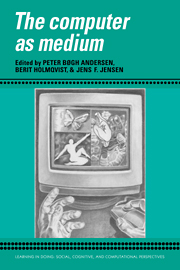Book contents
- Frontmatter
- Contents
- Series foreword
- Preface
- Contributors
- Part I Computer-based signs
- Part II The rhetoric of interactive media
- Introduction
- 6 Narrative computer systems: The dialectics of emotion and formalism
- 7 Interactive fiction: Artificial intelligence as a mode of sign production
- 8 Plays, theaters, and the art of acting in the eighteenth century: A formal analysis
- 9 The meaning of plot and narrative
- 10 Face to interface
- 11 Drawing and programming
- 12 Hypermedia communication and academic discourse: Some speculations on a future genre
- Part III Computers in context
- Index
9 - The meaning of plot and narrative
Published online by Cambridge University Press: 05 October 2010
- Frontmatter
- Contents
- Series foreword
- Preface
- Contributors
- Part I Computer-based signs
- Part II The rhetoric of interactive media
- Introduction
- 6 Narrative computer systems: The dialectics of emotion and formalism
- 7 Interactive fiction: Artificial intelligence as a mode of sign production
- 8 Plays, theaters, and the art of acting in the eighteenth century: A formal analysis
- 9 The meaning of plot and narrative
- 10 Face to interface
- 11 Drawing and programming
- 12 Hypermedia communication and academic discourse: Some speculations on a future genre
- Part III Computers in context
- Index
Summary
The computer was developed as a tool for handling large amounts of informations and for performing complicated calculations. But since the middle of the 1980s, when the personal computer came within the reach of ordinary people, the computer has taken over a wide range of functions, such as word processing, designing, book keeping, information handling, communication, and so on. From being a tool the computer has become a medium.
It is characteristic of other media that they are normally used for both commercial and artistic purposes, in what seems to be some kind of division of labour. On the one hand, the commercial products extend the market and inspire technical innovations for mass production. On the other hand, the artistic productions explore the medium, extend the language used and invent new ways of looking at the world. That is true of the, literature and a modern medium, such as the video. We have advertising and other commercial videos, art videos, and in between we have the music videos. Sometimes they are purely commercial products aiming at promoting a record, but they can also be very artistic productions, where the images are an integrated part of the music.
This dichotomy between entertainment and art is only one dimension of another dichotomy – the one between fact and fiction, or as I prefer to call it, faction – since we are dealing with the presentation of facts in media (mediated facts), not with actual facts.
- Type
- Chapter
- Information
- The Computer as Medium , pp. 209 - 221Publisher: Cambridge University PressPrint publication year: 1994



